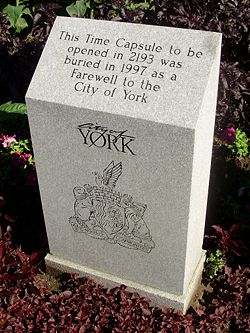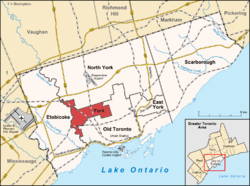- York, Ontario
-
This article is about the former city that was amalgamated into Toronto. For the regional municipality north of Toronto, see Regional Municipality of York. For the historical part of Toronto that existed in 1793–1834, see York, Upper Canada. For other uses, see York (disambiguation).
York — Dissolved municipality — Motto: From individuals, a community (translated from Latin: E singulis communitas) Location of York (red), as compared with the rest of Toronto. Country  Canada
CanadaProvince  Ontario
OntarioMunicipality  Toronto
TorontoIncorporated 1793 (township)
1 January 1967 (borough)
June 1983 (city)Changed Region 1954  Metropolitan Toronto from York County
Metropolitan Toronto from York CountyAmalgamated 1 January 1998 into Toronto Government – Mayor Rob Ford (Toronto Mayor) – Governing Body Toronto City Council – MPs Carolyn Bennett, Andrew Cash, Joe Oliver, Mike Sullivan – MPPs Laura Albanese, Eric Hoskins, Mike Colle, Tony Ruprecht Area[1] – Total 23.18 km2 (8.9 sq mi) Population (2001)[1] – Total 150,255 – Density 6,482.1/km2 (16,788.6/sq mi) Time zone EST (UTC-5) – Summer (DST) EDT (UTC-4) Area code(s) 416, 647 York is a dissolved municipality in Toronto, Ontario, Canada. Geographically, it is located northwest of Old Toronto, southwest of North York and east of Etobicoke, where it is bounded by the Humber River. Formerly a separate city, it was one of six municipalities that amalgamated in 1998 to form the current city of Toronto. The City of York itself was the amalgamation of several villages, including the present day neighbourhoods of Lambton Mills and Weston. Its population, as of the 2001 census, was 150,255, the second smallest of the six former municipalities, yet it is one of the most ethnically diverse. By the 2006 census, the population had fallen somewhat to 143,255.
Contents
History
York Township was incorporated by Canada West in 1850 (Canada West later became Ontario in 1867 due to the Confederation), bounded in the west by the Humber River, in the east by what would become Victoria Park Avenue, and in the north by what would become Steeles Avenue. Etobicoke Township and Scarborough Township were located west and east, respectively, while the townships of Vaughan and Markham bordered on the north.
Humewood–Cedarvale was developed in the 1910s to attract development in the growing township. Oakwood–Vaughan was also developed during this time. In the 1920s, the character of the township changed, with its southern reaches abutting the city of Toronto taking on a more urban character, compared with the very rural character of the north. The decision was made to split the township in two, with the northern, rural portion becoming North York. The remaining, two pockets of unincorporated urban development at the north end of the city, were split by the village of North Toronto, which was by then a part of the City of Toronto. Within years, the Province of Ontario saw that this arrangement was impractical, and further subdivided York, creating the township of East York out of the eastern pocket. The Township of York contracted streetcar and bus services from the Toronto Transportation Commission (later became Toronto Transit Commission in 1954), but remained independent from Toronto. During this time, American novelist Ernest Hemingway resided in the Humewood–Cedarvale community, writing for The Toronto Star.
Vaughan Road Academy (in the Oakwood–Vaughan neighbourhood) was York's first high school. It was built in 1926 and was known as Vaughan Road Collegiate Institute until 1997, along with York Memorial Collegiate Institute at Eglinton Avenue and Keele Street in 1929.
York was part of the federation of twelve suburban municipalities that joined Toronto in 1954 to form Metropolitan Toronto. York's first and largest library, York Public Library, was built near the intersection of Eglinton Ave. and Dufferin St. in 1964, later renamed Maria Shchuka and rebuilt in 2003. In 1967, it absorbed the village of Weston, and became the Borough of York, later known as the City of York. It was amalgamated into the new City of Toronto on 1 January 1998. Since amalgamation, Maria Shchuka is part of the Toronto Public Library system.
The York Civic Centre is located at 2700 Eglinton Avenue West, between Black Creek Drive and Keele Street, near York's Museum and York Memorial Collegiate Institute.
Demographics
 This time capsule outside the York Civic Centre is intended to be sealed for 196 years. It also depicts the city's logo and coat of arms, which contains the city's motto in Latin.
This time capsule outside the York Civic Centre is intended to be sealed for 196 years. It also depicts the city's logo and coat of arms, which contains the city's motto in Latin.
All statistics are taken from the Canada 2006 Census.[1]
- 57.5% White (predominantly Portuguese, Italian)
- 15.5% Black (predominantly Jamaican, African, and other Caribbean)
- 7.3% Latin American (predominantly Salvadoran, Mexican, Ecuadorian, and other South/Central American)
- 5.7% Filipino
- 4.3% South Asian (predominantly Indian)
- 2.7% Southeast Asian (predominantly Vietnamese)
- 2.3% Chinese
- 4.5% Other
As of 2006, more than half of York's population were foreign born. 51.8% were immigrants.
Among non-visible minority groups, the largest group in York are Portuguese people (southern half of Oakwood–Vaughan and along the whole southern part of York). St. Clair West, Rogers Road, Caledonia Road, and Dufferin Street have many Portuguese businesses. Eastern European and Jewish populations live mainly in Humewood–Cedarvale in the east end of York. There used to be a large Italian population along St. Clair West, but most have moved out to the suburbs like Woodbridge. Many Portuguese and Latin Americans live along St. Clair now. There are still many Italian businesses along the street, which is still called Corso Italia, and every year has the Corso Italia festival.
The largest visible minority group in York are Blacks who live along Eglinton Avenue West, Weston Road, and Jane Street. Several neighbourhoods had more than 30% of its population being Black such as Weston, Eglinton West, Mount Dennis, Woolner, and Oakwood–Vaughan. Many are Caribbean people with most being from Jamaica. Eglinton West is also known as Little Jamaica, home to many West Indian businesses. York also has a large Black African community with many people coming from Ghana, and Nigeria. Out of all the former cities of Toronto, York has the highest percentage of Black Canadians.
Most of the Latin Americans are from Central America. There are also a large number of people from Ecuador and Argentina. They are spread throughout York with almost every neighbourhood having a presence of Latin American people and businesses. St. Clair West is home to many Latin American restaurants and nightclubs. It also hosts many Latino festivals, including "Salsa on St. Clair" which attracts hundreds of thousands of people every year. It is Canada's biggest celebration of Latino culture. Out of all the former cities, York also has the largest percentage of Latin Americans. It is also the fastest growing minority in York, along with Filipinos, who concentrate in the eastern half of the former city. They are the fastest growing minority in York along with Latin Americans.
York also has a large Southeast Asian community, whom many are from Vietnam. They mainly live in the west end of York.
York has the lowest percentage of South Asians and Chinese people out of all the former municipalities of Toronto.
The religious demographics of York vary from Roman Catholic in the southern half Oakwood-Vaughan to Anglican in Weston to Jewish in Humewood–Cedarvale to even Rastafarian in Little Jamaica in the northern half of Oakwood-Vaughan and west along Eglinton Avenue to slightly west of Keele Street. There are also significant numbers of Seventh-day Adventists, Pentecostals and Evangelical Christians.
Crime
See also: Crime in TorontoIn 2009, Keele Street and Eglinton Avenue West became a "hot spot" in terms of crime in the Toronto, along with Jane and Finch. Crime in the city as a whole has steadily decreased, but in 2009, a spike in violence occurred in the York-Weston area. The area only accounts for 4.5% of Toronto's population, but had almost one-third of Toronto's homicides that year. Nonetheless, the area's number of homicides fell significantly in 2010.
12 Division police believed that a gang war between The Gatorz and the Five Point Generals may have been responsible for the rise in violence that year. Innocent people were caught in the crossfire with people getting shot to death waiting at a bus stop, and five-year-old girls playing in their backyards.[2]
The police had a massive drug sweep during the spring of 2009 around the Keele and Eglinton area called Project Spring Clean, which closed many grow-ops and crack houses and left 120 people facing more than 400 charges. Of the arrested were two Five Point General leaders. 12 Division police have also added extra personnel in the area and Toronto Anti-Violence Intervention Strategy (TAVIS) police officers.[3] They also planned the implementation of more police cameras on major intersections of York. The elevated levels of crime of 2009 were not sustained into 2010.[citation needed]
Media
York has a local community newspaper called the York Guardian. It is published by Metroland Media Group, which also publishes several other local papers in the Toronto area. Metroland Media Group is owned by Torstar Corporation, publisher of the Toronto Star.
Education
The Toronto District School Board operates English-language secular public schools. Before its 1998 merger with the other secular school boards of Metropolitan Toronto, the Board of Education for the City of York operated those schools. This merger was the result of the amalgamation of city and metro services that occurred that year.
Transportation
The former city of York is the only municipality not to touch any major expressway, though Allen Road's southernmost stretch is at the York-Old Toronto boundary and Highway 400 is only a few metres away from the York-North York boundary. Black Creek Drive runs through the former city of York however.
The subway system runs under the former City of York between Eglinton West and St. Clair West stations and between Old Mill and Jane stations. Only the Heath Street exit of St. Clair West station is in York proper, as Eglinton West station lies a few metres north of the York-Old Toronto boundary in Old Toronto, while Old Mill station is a few metres west of the Humber River and Jane station is on the eastern side of Jane Street.
The former City of York has 2 proposals to construct an underground rapid transit line under Eglinton Avenue: the cancelled Eglinton West line and the upcoming Eglinton–Scarborough Crosstown line.
Reeves and mayors
Following the 1966 election, the chief magistrate of York, formerly known as the reeve, assumed the title of mayor.
The following are the reeves of the Township of York:
- George Stewart Henry (1906–1910) – later as Premier of Ontario
- R.J. Stuart (1934–1935)
- W.M. Magwood (1936–1937)
- F.J. MacRae (1938–1946)
- C.J. McMaster (1947–1948)
- W.G. Beech (1949–1951)
- Fred W. Hall (1952–1956)
- Chris A. Tonks (1957–1960) – father of Alan Tonks
- Fred C. Taylor (1961)
- Walter Saunders (1962)
The following individuals served as York's mayor:
- Jack Mould (1966–1969)
- Philip White (1970–1978)
- Gayle Christie (1978–1982)
- Alan Tonks (1982–1988)
- Fergy Brown (1988–1994)
- Frances Nunziata (1994–1997)
See also
- List of neighbourhoods in Toronto
- List of people from Weston
References
- ^ Community Profile: York city , Ontario; Statistics Canada Statistics Canada (2001). Retrieved on 11 May 2007.
- ^ http://www.citytv.com/toronto/citynews/news/local/article/10856--five-yr-old-girl-shot-after-being-hit-by-stray-bullet-in-apt
- ^ http://www.theglobeandmail.com/news/national/toronto/torontos-new-murder-capital/article1222907/
Former municipalities of Toronto by year of amalgamation 1883-1912 1883: Yorkville · 1884: Brockton · Riverdale · 1888: Seaton Village · 1889: Parkdale · 1890: Bedford Park · Davisville · 1905: Rosedale · 1908: Deer Park · East Toronto · 1909: Bracondale · West Toronto · Wychwood · 1910: Moore Park · North Toronto · 1912: Dovercourt · Earlscourt1967 1998 Coordinates: 43°41′23″N 79°28′41″W / 43.689829°N 79.478066°W
Categories:- Black Canadian settlements
- Former municipalities in Toronto
- Former cities in Canada
- Metropolitan Toronto
- Neighbourhoods in Toronto
- Populated places disestablished in 1998
Wikimedia Foundation. 2010.

